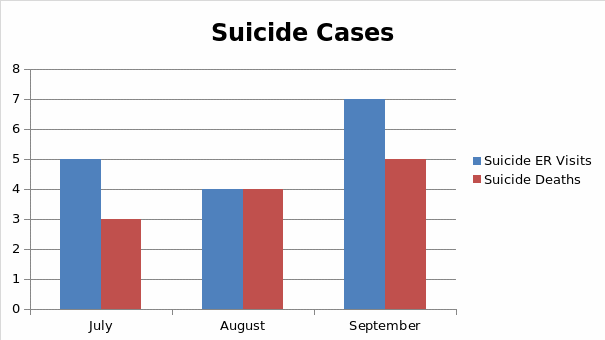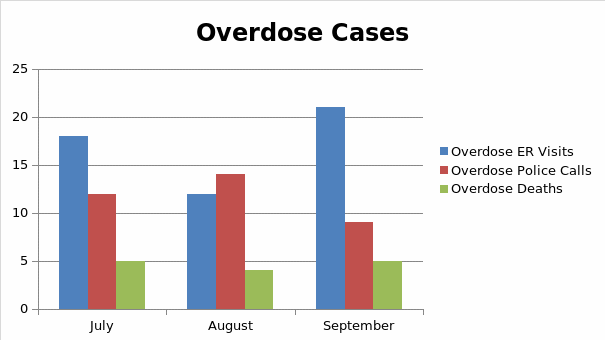Introduction
This economic evaluation concerns the program developed to help prevent suicide and drug overdose in Racoon City. Suicide and drug overdose present severe problems for young people who represent approximately 35% of the total Racoon city population (Program Evaluation Scenario). This age category presents the experimental group in the given evaluation scenario (Mertens & Wilson, 2018, 5). In a span of three months – July, August, and September – ER registered 51 visits due to drug overdoses and 16 visits due to suicide attempts (Program Evaluation Scenario). In addition, police received 35 overdose calls requiring the use of Narcan (Program Evaluation Scenario). Nevertheless, 14 and 12 deaths were registered due to overdose and suicide, respectively (Program Evaluation Scenario). To reduce the number of overdose cases and suicide attempts in the long term, the local primary care center decided to screen patients during routine doctors’ visits for drug abuse and suicidal ideation. The program’s annual cost is $ 150,000; one ER visit, including the ambulance ride, costs $ 2,168; Narcan administration costs $ 200 per use (Program Evaluation Scenario). Consequently, the evaluation will proceed in four aspects: Cost-of-illness, programmatic cost, benefit-cost, and cost-effectiveness.
Cost-of-Illness Analysis
Cost-of-illness (COI) analysis represents the analysis of possible disease economic impact. According to Five-Part Webcast on Economic Evaluation (CDC, 2017b, part 2), COI usually includes the costs associated with medical care resources’ expenditures for disease treatment. In addition, productivity loss can also be included in COI to assess the individual production potential. COI can be either prevalence-based or incidence-based; the former refers to the total disease cost over the specified period, while the latter estimates the life-long costs (CDC, 2017b, part 2). Given the provided scenario describes monthly and annual expenses, prevalence-based COI would be a better fit for this evaluation. In total, there were 67 ER visits in three months, making it approximately 22 visits per month. The cost of a single visit is $ 2,168; thus, the city would have to pay roughly $ 572,352 for ER visits annually. In addition, approximately 12 police calls per month due to overdose result in $ 28,800 in costs for Narcan administration. Since the targeted group represents young people, their contribution to production is either absent or relatively small, making the productivity loss analysis irrelevant.
Programmatic Cost Analysis
Programmatic cost analysis is sometimes called cost outcome, cost consequence, or cost-minimization analysis. Generally, it focuses on the cost of the resources required to undertake an intervention (CDC, 2017b, part 3). It can be conducted both prospectively and retrospectively – the former concerns the evaluation of the program’s efficiency or efficacy during its development; the latter focuses on the costs when the program’s efficiency is already known. The term “resources” represent the sources of expenditures in terms of required personnel, equipment, and supplies, as well as the space needed for the intervention. Programmatic costs can be further classified into financial and economic: financial concerns direct costs of the program, while the economic ones emphasize opportunity costs. The given scenario provides the following information relevant to the programmatic cost analysis: the program’s annual cost and the number of additional workers. Annually, the program maintenance would cost the Racoon City primary care center $ 150,000; two LCSW social workers were hired to conduct the patient screening during their primary care visits. Thus, there are only direct programmatic costs present in the evaluation.
Benefit-Cost Analysis
Benefit-cost analysis (BCA) is the economic evaluation that ties a specific program’s costs and benefits to the same measure – dollars. BCA is usually conducted retrospectively when the program has already proven effective but before it is widely implemented (CDC, 2017a). In addition to the standardization of results, it provides their value over time, making it a perfect tool in regulatory policy analysis (CDC, 2017b, part 4). Considering the given evaluation scenario, BCA should compare and contrast COI and programmatic costs. Approximate $ 600,000 annual disease costs and $ 150,000 in programmatic costs present a four-to-one ratio. Thus, the program can be considered efficient as soon as it manages to decrease the overall amount of overdose cases and suicidal attempts by more than a quarter.
Cost-Effectiveness Analysis
Analogically to BCA, cost-effectiveness analysis prioritizes the intervention costs and its outcomes. However, in this case, the standardization does not occur in dollars but in health units, such as preventing disease cases or saving lives (CDC, 2017b, part 5). Apart from that, the area and the timing of the analysis coincide with the BCA. In the provided scenario, a cost-effectiveness analysis will concern the total number of overdose cases and suicidal attempts and the fatal outcomes of both. If the program required to reduce the mentioned numbers by more than 25% to be considered efficient, it would mean approximately 51 fewer cases of overdose, 16 fewer cases of suicide attempts, and 26 fewer deaths annually among the youth in Racoon City.
Conclusion
The economic evaluation of the provided scenario was conducted in four dimensions: cost-of-illness, programmatic, benefit-cost, and cost-effectiveness analyses. In the provided case study, COI analysis would consider the annual amount spent on ER visits and Narcan use during police interventions. The programmatic analysis takes into account the expenditures on program maintenance and the number of additional workers hired. The benefit-cost analysis will compare the results of the first two in terms of the dollars required. Finally, the cost-effectiveness analysis will convert those results into the number of successful preventions and saved lives.
References
Centers for Disease Control and Prevention (CDC). (2017a). A Framework for Program Evaluation. Web.
Centers for Disease Control and Prevention (CDC). (2017b). Five-Part Webcast on Economic Evaluation. Web.
Mertens, D. M., & Wilson, A. T. (2018). Program evaluation theory and practice. New York, NY: Guilford Publications.
Program Evaluation Scenario: Suicide Prevention [Course handout]. (n.d.).
Appendix

